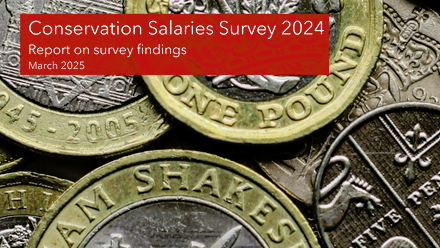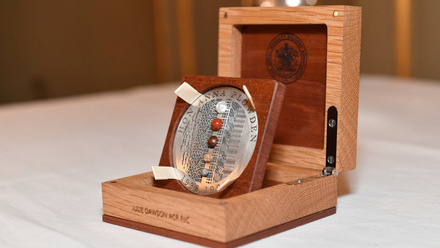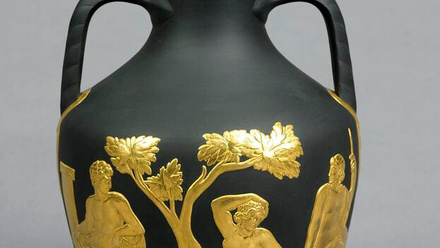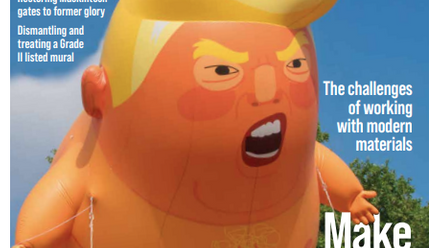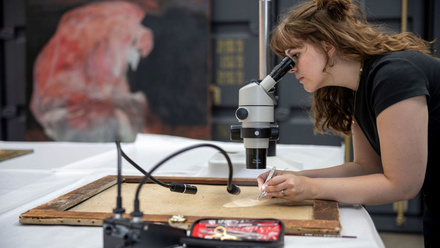In May, Icon presented the first ever Marsh Awards for Conservation and Restoration of Objects and Collections, in partnership with the Marsh Charitable Trust.
Below we chat to Kate Jennings, who was awarded a Special Commendation for the Marsh Research in Conservation Award.
2023 Marsh Award: Research in Conservation
Highly Commended: Kate Jennings, Icon Associate member Project role: Metalwork Conservation Subject Leader, West Dean College of Arts and Conservation Project outline: Replicating Old Sheffield Plate. This collaborative project benefited both the Winterthur Institute at the University of Delaware and West Dean College students, helping them to learn the nuanced process of fused silver plating.
What does it mean to you to receive a special commendation for this award?
It's an important recognition of the contribution that craft skills can make in conservation practice and research.
You’ve been nominated for your project replicating an Old Sheffield Plate, a fused form of silver and copper alloy from the late 18th – early 19th century. Can you briefly explain how research unfolded for this project?
I was approached by Winterthur/University of Delaware to collaborate on a research project. The project is aimed at ascertaining why nitrocellulose-based lacquer coatings seem to deteriorate more quickly and more extensively on Old Sheffield Plate objects than solid silver or electroplated objects. In order to carry out quantified research they needed test tokens representing the Old Sheffield plate process as well as a variety of other substrates.
Nobody has made plated silver using the Old Sheffield plate process commercially for several decades, so we agreed to see if we could replicate this process based on historical reference material and some investigatory work Winterthur has carried out on objects in their collection. After various rounds of testing we successfully produced sufficient material for Winterthur to use in their experiments, the results of which will be published shortly.
Why is conservation-led research important?
The reasons why conservation-led research is important can be summarised into two broad areas.
The first is because of the access and the time that conservators get to spend with objects, and the opportunities this provides to understand objects at a level that is often not available to many other people. A comprehensive understanding of the issues affecting objects often only comes into full focus after some combination of physical investigation, analytical work, technical and/or art historical research, testing of treatment strategies, revision of understanding, further investigatory work, modification of treatment strategies, further testing and refinement. Whilst carrying out this full spectrum of work is not possible for every object, given time and repetition over multiple objects conservators can build up in-depth understanding of common issues, effectiveness of current solutions and important gaps in understanding that would be helpfully addressed by further research.
The second is because of the ability and drive that conservators have to put all of this information together - all of the conservators I know are deeply passionate about their areas of practice, and are always looking for ways to improve results for both objects and the people who have an interest in or connection with those objects.
Resources are generally limited in both the arts and heritage sectors, so it's important that they are directed where they will have the most impact. Conservators are often in a good position to help advise where research might most beneficially be directed because of their expertise and ability.
The Old Sheffield Plate project is an excellent example of this, as it came about because of the visual observations that multiple generations of conservators have made about discrepancies in lacquer deterioration rates on different types of silver objects - and then seeking to understand why this may be happening.
Disseminating research outputs and promoting them to colleagues is really important. What are some of the ways in which you shared your research with the community?
I am relatively new to conservation research - so far my work and teaching has been mainly practice-led. However, I am keen to develop my understanding of effective ways in which to disseminate research. Research is only useful to the extent that people know about it - as a colleague once said to me, research is only research when it's published, otherwise it's a hobby!
Traditional routes such as journal publications are effective to a certain degree - they provide a known resource for people to consult when researching a new issue or nuance to an existing area of knowledge. However, access to journals can be expensive which sometimes limits accessibility.
Research is only research when it's published, otherwise it's a hobby!
Newer platforms such as YouTube provide interesting and accessible resources, which I've participated in (in a small way) with Icon's Dynamic Objects Network to provide freely accessible information covering a wide range of conservation topics.
Even short posts on social media such as Instagram and Twitter can be effective in disseminating bite size pieces of knowledge and research - I have learnt a lot from following various conservators and craft metalworkers.
One of the best examples I can think of showing effective dissemination of research outputs at the moment is the Endless Metal project that has created a website with all sorts of resources related to the three metal conservation tools they've been developing - the diversity of media (academic papers, online tutorials and videos) available means it accommodates a variety of levels of starting knowledge as well as preferred learning styles.
Your nomination praised you for the work you do as a subject leader. Why is it important to you to support your students and encourage them to make connections within the conservation community?
It's important to me to support my students for many reasons, but the most important ones are firstly because whilst conservation is an endlessly fascinating job it can also be quite a demanding area in which to work.
The challenges that are thrown at conservators can be unconventional and varied, and the resources we have to solve those challenges are often limited.
For new conservators I think those challenges can be particularly intimidating, so one of the most important skills I think I can give my students is to learn to be comfortable with being creative, resourceful, and practical problem solvers.
I want to put my students in the best position to be successful in whatever they choose to do, and unfortunately I never have enough time to teach them everything I would like to teach them - so the next best skills I can teach them is how to figure things out for themselves, along with the resilience to adapt to situations that haven't worked out exactly as planned the first time!
One of the most important skills I think I can give my students is to learn to be comfortable with being creative
The second reason why it's important to me to support my students is because of the commitment and contribution that they are making to the field of conservation. Training opportunities in conservation have never been easy to come by, and funded ones even less so.
However, the costs associated with becoming a conservator are accumulating rapidly, and those costs are mainly being borne by the people seeking to enter conservation themselves.
Generally, students will already have undertaken an undergraduate degree which, for a British student studying in the UK, will most likely have cost them somewhere in the region of £27,750 in tuition fees alone. This is then followed by one or more likely two years of post-graduate conservation education, which will cost them anywhere from another £9,000 to £14,900 per year for tuition fees alone - and for international students the costs are frequently much higher.
Whilst scholarships are available to some students to help with tuition fees, funding is rarely available for living costs so frequently personal debt levels are pushed higher by this factor. It also limits the diversity of our sector in an important way. This is because (as has been shown by multiple studies) prospective students from lower socioeconomic backgrounds are disproportionately deterred from entering Higher Education by high tuition fees - a situation that seems likely to worsen given the current cost of living pressures.
Despite this financial burden, and the known precarity of the working arrangements most commonly available to new conservators (a patchwork of short-term contracts that often require regular relocation), students keep seeking entry to the conservation profession. And that is essential because the future of the conservation profession is only as good as the people we are bringing into it, the education they get and the opportunities for development that they find afterwards.
The reason why it's important to make connections within the conservation community is because of all the chances and opportunities that seem lucky, but are more often a product of that nebulous web of connections between individuals which brings key information, resources and advice when needed.
Many of the opportunities that I have had and support that has been given to me has come about as a result of being able to call upon friends, professional contacts and friends of friends when I needed support or advice, so I would encourage all conservation students to make connections within the conservation community widely but also generously - don't forget that the best relationships always work in both directions.
The future of the conservation profession is only as good as the people we are bringing into it, the education they get and the opportunities for development that they find afterwards.

